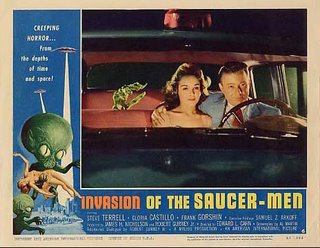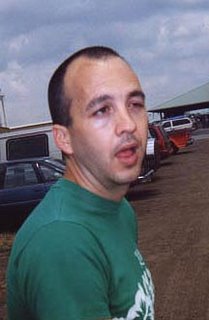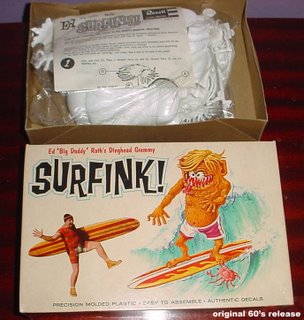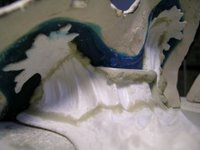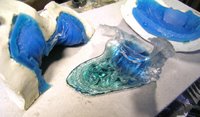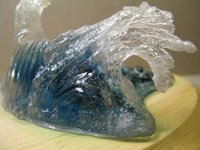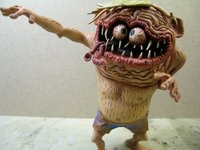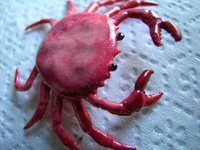The Day the Clown Cried
There.
You either get him...or you don't. There's nothing intellectual in "getting"
him, as a lot of the crypto-film-nerds would have you to believe. Surreal comedy is an acquired taste and some people don't see it. Fine.
I don't see what so great about American Idol. And in that comparison, it seems people would rather watch people's dreams crushed by rude no talent hacks, than watch a guy spaz out to just get a laugh.
So...that being said...I've seen just about everything Lewis has ever done. Some, I like more than others, (Nutty Professor, The Errand Boy, Way Way Out, The Bell Boy, The Big Mouth, The Ladies Man, etc.) some I could care less about (The Delicate Delinquent , Hardly Working,...no surprise there...and The Geisha Boy). There is one film that he worked on that I haven't had the pleasure to view. As a matter of fact, only a hand full of people have seen this film.
The Day the Clown Cried. (1972)
I heard about this Lewis film in the early, early 80's, and being the Lewis fan then, I became obsessed with it. I heard it was the most ghastly concept and that Lewis' performance was legendary. Before VHS and before the internet could share data bases and files, I thought that TDCC was a myth...or had died early in the writing. All I was getting years ago was word of mouth. Surely, nothing this insane could have been filmed, edited and screened. If you haven't ever heard of this film, let me fill you in on the story:
It's World War Two (already a bad start) and Lewis plays a German clown named Helmut Doork (!?). He's fallen in the ranks at the great circus and rages on in hopes of being number one again. The problem is he's a mean drunk and a jerk. He goes on a drunken speil at a tavern accusing the great Adolph Hitler and his mad schemes for making his job harder (it's always someone else, eh?). While literally falling down drunk (Jerry Style), he lands at the feet of two Gestapo agents who arrest him for ridiculing their Furher. He's interrogated and gives up names of everyone he knows, anti-Hitler or not, just to save his skin. Not too funny so far.
No belly laughs here.
He's taken to a political prison adjacent to a concentration camp where he's tortured and ridiculed all the while signing his own praises as a great clown. When he tries to stand up to his wardens and then beaten down, he criticizes himself for showing any backbone. At one focal point, he's thrown down in the mud and notices the children laughing at him from the concentration camp side. He makes an effort to apply mud to his nose and this makes the children laugh harder. More children gather at the fence who laugh. He then exclaims, "Look....They're laughing at me. I am a great clown!" The children are some sort of catalyst and he works for only them. (This is where art imitates life with Lewis...children in need of a clown) He takes soot from the stove to work up some make up, some bird droppings for the white base, trades some food for a larger man's shoes and coat, and starts really giving the kids some performances.
Can you see it coming? It's kinda' like a hard knot in the back of your throat, huh?
The head Nazi sees how Jerry can handle the kids and is ordered to entertain them for their duration. Eventually they are herded onto a train boxcar and are headed for Auschwitz. To quiet the children and keep them distracted, the Nazis force Jerry to ride on the boxcar as well. He ends up going to Auschwitz with them and then is told to lead them to the gas chambers. The children thinks it's just showers, but
Jerry's character knows differently and yet does nothing. He entertains them to the very chamber door and enters in with them. The door closes
behind them and they're gassed. The End.
WOW!
What a f***king bummer!
The original screenplay was written by publist Joan O'Brien and TV critic Charles Denton as far back as the mid 60's. O'Brien got the genesis for this while working with Emmett Kelly, the lengendary clown...and apparently while reading books on the Holocaust. The idea of the children that were sent to the gas chamber was too horrible to imagine, so the influence of working with Kelly became a natural catalyst for the idea. According to O'Brien, Kelly told her that he wasn't nervous playing to large audiences because he wasn't playing to the grown ups...just the kids.
To make the picture, O'Brien and Denton optioned it to many producers who got the interest of stars like Milton Berle, Dick Van Dyke, and Bobby Darin. Eventually in 1971 a producer, Nathan Wachsberger (Starcrash..They Came to Rob Las Vegas) optioned
on it and took it to Jerry to star and direct. Jerry was a little taken back
at the idea at first..."Why don't you get Sir Laurence Olivier? My bag is comedy...and you're asking me if I'm prepared to deliver helpless kids into a gas chamber. Ho ho...that's some laugh. How do I pull it off?"
Wachsberger assured Jerry that he got funding from French and Swedish backers and they'd be using the Europa Studios in Stockholm (where Bergman shot several of his films). Jerry read over the script and made changes. He felt it was something he needed to do now..it was his time to make serious films. He said then..."What a horror...it must be told." , and later he wrote "I thought (the film) would be a way to show we don't have to tremble and give up in the darkness...Helmut would teach us this lesson."
I think the main reason Lewis did the film was what addicts call being on the "Pink Cloud". He had just kicked a Percodan addiction and was very proud of himself for doing so. Addicts get happy and excited once they kick something and feel rather invincible and start wanting to "pay back" the ones who might have suffered...or give
something to society. These emotions usually run toward grandiose dreams and sometimes are focused toward religious projects. You can thank booze for Mel Gibson's "The Passion of the Christ". Quite a lucrative and well made "Pink Cloud"...but one none the less.
Jerry jumped into the role with gusto and while doing a final rewrite, he went on a grapefruit diet and lost 35-40 pounds to simulate a starved war criminal. Shooting started in Paris, Feb. 1972 and then onto Stockholm in April. According to Lewis, even before shooting started Wachsberger took off to the south of France and the financial backing disappeared with him. Lewis started spending his own money (because "it must be told") to keep the project going, but his funds were at a strain in '72. To make matters worse, Wachsberger never actually paid for the full use of the script, and the option had run out long before shooting started. O'Brien has stated that Lewis knew the option had run out and he was making a movie he had no legal right to make. This cumilation of using his own money (for a projected 1.5 million dollar production) and using a script that wasn't even cleared, put a tremendous strain on him as an actor and director. People on the set, and who saw the edited works later, said the strain shows in his performance. His anger for Wachsberger comes to the surface, as only Jerry could emote.
Jerry saw things differently: "The suffering, the hell I went through with Wachsberger had one advantage. I put all the pain on the screen. If it had been my first picture, the suffering would have destoyed me. But I have the experience to know how to use suffering....I was terrified of directing the last scene. I had been 113 days on the picture, with only three hours of sleep a night. I had been without my family...I was exhausted...beaten. When I thought of doing that scene, I was paralyzed; I couldn't move. I stood there in my clown's costume, with the cameras ready. Suddenly the children were all around me, unmasked, undirected and they clung to my arms and legs, they looked up at me so trustingly. I felt love pouring out of me. I thought, 'This is what my whole life has been leading up to.' I thought what the clown thought. I forgot about trying to direct. I had the cameras turn and I began to walk, with the children clinging to me, singing, into the gas ovens...and the doors closed behind us."
According to a SPY magazine article on TDCC, there was no on set documentation. Not true. Lewis wouldn't shoot a foot of his magnum opus without proof he was sweating blood. I've seen only seconds of this footage, but it does exist.
By June the picture's principal photography had wrapped and Lewis openly voiced his
business dealings with Wachsberger to the Swiss press. On some legal grounds, Wachsberger had his lawyers sue Lewis on breach of contract, siteing that he couldn't finish the film without Lewis' help now. Lewis put his back into it and used his editor Rusty Wiles through the winter and then the spring, to cut a version together. That version is the only one to be seen by the lucky (?) few. Europa Studios have refused to give up the negative claiming that they are stilled owed 600,000 clams. Trying to get it finished, Lewis showed the cut to O'Brien and Denton to get them to renew the option. This was a bad thing. According to Denton later, "It was horrible...In one scene, Jerry is lying in his bunk wearing a pair of brand new shoes after theoretically having been in a concentration camp for four or five years."
From all reports from the people that have seen it, Jerry plays is cold, flat and the humor is so terribly wrong as to be legendary.
Harry Shearer, who saw the rough cut in the 80's, has said," If you say'Jerry Lewis is a clown in a concentration camp' and you make that movie up in your head, it's so much better than that...and by better I mean worse. You're stunned. With most of these kinds of things, you find that the anticipation, or the concept, is better than the thing itself. But seeing this film was really awe-inspiring, in that you are rarely in the presence of a perfect object. This was a perfect object. This movie is drastically wrong, it's pathos and it's comedy are so wildly misplaced, that you could not, in your fantasy of what it might be like, improve on what it really is. The closest I can come to describing the effect is if you flew to Tijuana and suddenly saw a black velvet painting of Auschwitz...It's not funny, and it's not good, and somebody's trying too hard in the wrong direction to convey this strongly held feeling."
An example of "wrong headedness", is in a scene where Lewis is freezing in his bunk because a guard removed his blanket. He gets up, goes off screen to the latrine to urinate, and the sound of ice cubes hitting the toilet bowl is heard. Yea..I would say that's a "wrong direction" to go with this subject matter.
O'Brien and Denton felt the same way, refused to allow this version to surface, and
that's where we stand today, 34 years later. Jerry has a rough cut and a VHS copy in his vault and doesn't take interviews on the subject. He says it will be released, but when....no one knows.
And still I wait to see the legend. Like camping out to spot Bigfoot...someday I will see this classic Lewis film...this Holy Grail of Kitsch. In all it's unreal bad ideas, horrific topic, and typical Hollywood pinky ring suave martyrdom...it's still preferred viewing over any episode of American Idol.



